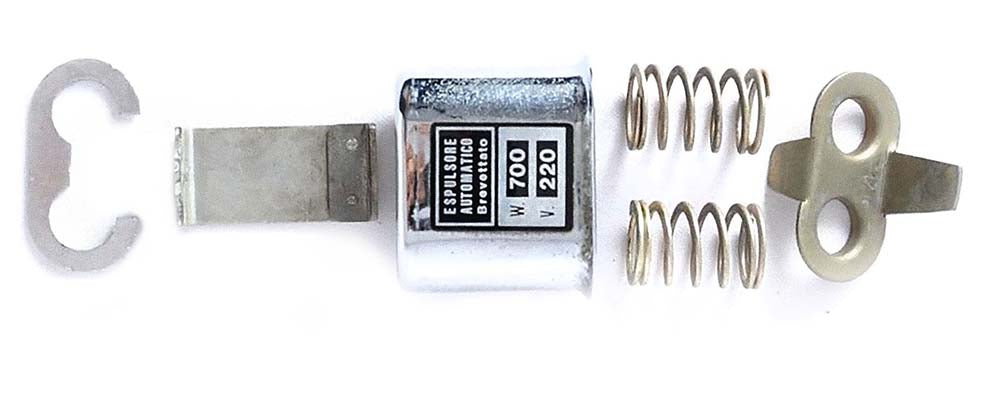FE-AR La Peppina
by Francesco Ceccarelli
A few years had passed since the invention of the first lever machines, such as the Gaggia Gilda and Faemina, and on the wave of their success at the end of the 1950s there were already numerous inventions of new models. Among these, La Peppina was born in 1957 thanks to Felice Arosio, who, to avoid any misunderstandings, called the company FE-AR using the initials of his name. Felice Arosio was not an enlightened beginner; on the contrary, he had behind him a definitely important and long-lasting project, the invention of the Faemina, in collaboration with Ernesto Valente, as shown by the original Faema patent of 1952. The success of the Faemina encouraged him to design and produce his own lever machine, experimenting with new materials and mechanisms in order to reduce costs and offer an attractive design. This led to the birth of La Peppina.
Numerous are the new features that overturn the traditional canons: the lever inserted in the base that drives the spring piston that pushes the water from below, the enamelled metal boiler, the removable power cord. The Peppina can be divided into three main components: the base that contains the lever-spring-piston mechanism, the grouphead that also includes the heater and the automatic ejector, the enamelled boiler with its lid.

La Peppina completely disassembled
Of particular interest is the automatic power cord ejection mechanism. The perforated flap on the left compresses the springs and engages the inner plate. The overheating of the unit causes deformation of the inner plate, which releases the flap while the springs provide the necessary force to disconnect the power cable.

Automatic ejection mechanism patented in 1961
La Peppina was initially produced it in four different colours, brown, red, yellow and green, to which blue and black were added over the years. It was immediately a great success, and the cost of approximately 25'000 lire, that equalled half the price of the more noble Faemina and Microcimbali, made it more affordable for Italians. Until 1970 each model was numbered progressively under the base, and in the period between 1959 and 1970 about 100'000 were produced. Subsequently, the progressive numbering was replaced by the year and month of manufacture and production continued until 1985, when changing market needs with the introduction of electric pump coffee machines and the FE-AR's inability to adapt to changes brought it to its end. It was also very imitated, in Italy by CELP and IMAS and in France by Comocafè, which FE-AR also sued.

The Peppina V 3.0 with boiler, body and base modified compared to the first model
In the 1980s, the classic model was joined by a model called "Termomatica". It is equipped with a thermostat that interrupts heating when the boiling temperature is reached and an airtight lid with a tube for steam production. A switch on the right of the grouphead allows the user to restart the heating for steam production.
In conclusion we can say that the success of the Peppina was determined by the fact that it had an attractive design that makes it still desirable today, it was cheaper than its competitors and it was one of the best domestic lever machines ever produced in terms of the quality of the coffee extracted. On the other hand, the corrosion over time of the components in contact with water, the lack of spare parts, and a rather complex maintenance process reduced its lifespan and makes it difficult to find specimens in perfect conditions.

La Peppina Termomatica
Simone, editor of The Lever, embarked on a new journey starting from July 2025.
He is volunteering in Nicaragua to learn about coffee farming and is documenting his journey through physical letters sent directly to your doorstep.
Curious to hear his experiences?